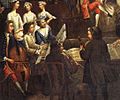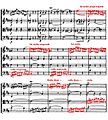Chamber music facts for kids
Chamber music is music written for a small group of instruments. The word "chamber" means a room, often in a large house or castle. Long ago, wealthy people had their own musicians. These musicians would play concerts in smaller rooms, or "chambers." This is how "chamber music" got its name.
In chamber music, each player has a unique part. This is different from an orchestra, where many violins might play the same notes. Chamber groups usually have two to nine players.
Sometimes, the word "chamber" is used for a "chamber orchestra," which is a small orchestra. A large orchestra is often called a "symphony orchestra." A small choir can be a "chamber choir." However, these are usually not called "chamber music."
How Many Players?
These words describe the number of musicians in a chamber music group. They can also be used for singers.
- A solo is for just one player or singer. This is not usually called chamber music.
- A duet or duo is for two instruments. A "duo" often means both parts are equally important. For example, a Piano duet is for two players at one piano.
- A trio is for three instruments. A common type is a piano trio, for piano, violin, and cello. Sometimes, a trio is named after an instrument, like Brahms’ "Horn Trio." This piece is for French horn, violin, and piano.
- A quartet is for four instruments. The String quartet is very popular. It uses two violins, a viola, and a cello. A piano quartet adds a piano to a string trio.
- A quintet is for five instruments. A string quintet might have two violins, two violas, and a cello. Or it could be two violins, a viola, and two cellos. A piano quintet is for piano and a string quartet. Schubert's "Trout Quintet" is special. It uses piano, violin, viola, cello, and double bass.
- A sextet is for six instruments. String sextets usually have two violins, two violas, and two cellos. Poulenc’s Sextet is for piano and five wind instruments.
- A septet is for seven instruments. These are quite rare. Composers like Beethoven and Saint-Saëns wrote septets. They used different instrument combinations.
- An octet is for eight instruments. Schubert’s Octet uses clarinet, horn, bassoon, a string quartet, and double bass. Mendelssohn’s Octet is for two string quartets.
- A nonet is for nine instruments. These are very rare. Louis Spohr wrote a nonet for violin, viola, cello, double bass, flute, oboe, clarinet, bassoon, and French horn.
History of Chamber Music
Chamber music became popular in the 17th century. It offered a different sound from large orchestras. Composers wrote trio sonatas. These were for two high instruments, like two violins. They also included a continuo accompaniment, usually a harpsichord and cello. Arcangelo Corelli and Johann Sebastian Bach wrote many trio sonatas.
Joseph Haydn wrote many string quartets. He helped make this group popular. Mozart and Beethoven also wrote amazing string quartets. Beethoven's last quartets were challenging to play and understand. But they inspired later composers. These included Schubert, Schumann, Mendelssohn, and Brahms. In the 20th century, Bartók and Shostakovich wrote some of the best string quartets.
Playing Chamber Music
Playing chamber music is a lot of fun. Each musician is important. It feels like having a musical conversation. There is no conductor, so everyone must listen carefully. Musicians learn to play together as a small team. They can also hear their own playing better than in a large orchestra.
Some modern composers write chamber music for young players. Some of Mozart’s early string quartets are not too hard. They are a great way to start playing chamber music.
Images for kids
-
Frederick the Great plays flute in his summer palace Sanssouci, with Franz Benda playing violin, Carl Philipp Emanuel Bach accompanying on keyboard, and unidentified string players; painting by Adolph Menzel (1850–52)
-
Plato, Aristotle, Hippocrates and Galen play a quartet on viols in this fanciful woodcut from 1516.
-
Baroque musicians playing a trio sonata, 18th-century anonymous painting
-
The Seine at Lavacourt by Claude Monet. Impressionist music and art sought similar effects of the ethereal, atmospheric.
-
The Kneisel String Quartet, led by Franz Kneisel. This American ensemble debuted Dvořák's American Quartet, Op. 96.
-
Béla Bartók recording folksongs of Czech peasants, 1908
-
Painting of Pierrot, the object of Schoenberg's atonal suite Pierrot Lunaire, painted by Antoine Watteau
-
Leon Theremin performing a trio for voice, piano and theremin, 1924
-
A graphic interpretation of the Burletta movement of Bartók's String Quartet No. 6, by artist Joel Epstein
See also
 In Spanish: Música de cámara para niños
In Spanish: Música de cámara para niños




















